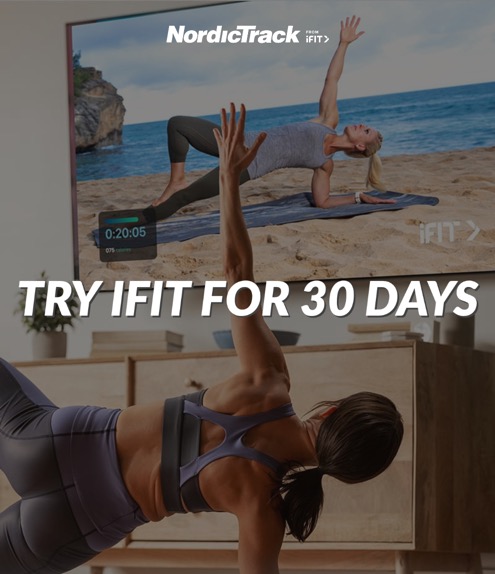
UPDATED 09/01/2025
When it comes to treadmill running, the right gear makes all the difference. If your shoes don’t feel right, neither will your stride. But how do you know which shoes are best for treadmill use? The good news: most of the same qualities that make great running shoes for outdoor runs also apply indoors.
The difference is that on a treadmill, your shoes work in partnership with the machine. That means cushioning, flexibility, and shoe weight matter even more — especially when paired with a treadmill built to protect your joints, like the NordicTrack Commercial 2450.
In this guide, you’ll learn what to look for in treadmill running shoes, how to match them to your stride and foot type, and why choosing the right treadmill + shoe combo leads to better runs.
Workout Routine: Match Shoes to Your Training Style
The first step in choosing running shoes is knowing your routine. Do you focus on long-distance endurance, interval training, or sprints? Each requires slightly different footwear:
- Intervals & HIIT: Choose lightweight shoes with strong grip for fast transitions. Pair them with a treadmill like the NordicTrack X16 Incline Trainer, which offers rapid incline/decline adjustments for explosive sessions.
- Distance Running: Look for cushioned, durable shoes. When combined with the Commercial 2450, you’ll have a joint-friendly surface for consistent, long miles.
- Walking or Jogging: Opt for supportive shoes with stability. A treadmill like the T Series 10 offers the balance of everyday comfort and incline variety.
Tip: Runners should replace shoes every 250–500 miles, as cushioning can lose up to 40% of its support over time1.
Flexibility: Shoes Should Move With You
Your running shoes should bend naturally at the ball of the foot and twist slightly. This flexibility allows your stride to feel smooth and helps prevent shin splints or stress fractures2.
Pairing flexible shoes with a treadmill that has SmartAdjust™ technology, like the NordicTrack Ultra 1, means both your shoes and treadmill adapt seamlessly to your body mechanics.
Sizing: Go a Half Size Up
Running shoes should generally be ½ size larger than your everyday shoes. This gives your toes room to move forward with each stride and prevents soreness from a tight fit.
Pro Tip: If your shoes feel snug, but your treadmill’s cushioning is forgiving — like the Commercial 1250 with RunFlex™ cushioning — you’ll still enjoy a comfortable run.
Shoe Weight: Lighter Is Better for Treadmills
Research shows lighter shoes reduce muscle strain and improve stride efficiency3. That’s especially true on treadmills, where repetitive motion amplifies small differences in weight.
Combine light shoes with a treadmill that reduces impact, such as the Commercial 1750, and you’ll feel faster, stronger, and more efficient.
Cushioning & Comfort: Double Up with Your Treadmill
Shoes with strong cushioning reduce impact, but when paired with a treadmill built with joint-friendly decks, the results are even better. For example:
- The X16 offers a cushioned deck that mimics dirt trails, reducing strain on knees and hips.
- High-arched runners or flat-footed runners can choose shoes with targeted cushioning while relying on the treadmill’s SpringFlex™ cushioning to balance stride impact.
Make sure your running shoes also have good shock absorption to avoid shin splints. With adequate cushioning in the sole and insole, your runs become more comfortable by reducing stress on your lower extremities1.
A stable heel counter adds another layer of support. It stabilizes your foot, reinforces shoe structure, and extends the shoe’s lifespan. Just make sure the heel counter fits comfortably against your heel — if not, it can cause blisters. Since most heel counters are moldable, they can often be adjusted with heat for a custom fit.
See how treadmill cushioning stacks up in our guide: Incline Treadmill Benefits: Why It Works Better Than Flat Walking.
Foot Shape & Strike Pattern: Running Shoes That Support You
The shapes of our feet vary from runner to runner, and they play a big role in choosing the right running shoes for treadmill training. Next time you step out of the shower, take a closer look at your bare footprint to assess your arch type. This quick test can help guide you toward the best shoe — and the best treadmill pairing — for your unique stride.
Standard Feet
Most shoes on the market are designed for a standard foot shape. These are the easiest to find and work well for many treadmill runners. However, if you feel discomfort, it may be worth trying a model built for more specific support. A versatile treadmill like the NordicTrack Commercial 1250 gives you a balanced training surface that matches this shoe type well.
Flat Feet
Flatter feet, or fallen arches, often need more support. Stability shoes are the best match here since they help prevent excess rolling that can lead to ankle twists. Pairing these shoes with a high-incline treadmill like the NordicTrack X16 Incline Treadmill can also strengthen stabilizer muscles over time
High-Arched Feet
Runners with high arches tend to roll their feet outward. Shoes with extra absorption and flexibility help reduce strain. Look for models with supportive ankle collars and cushioned midsoles. On the treadmill side, the NordicTrack Ultra 1 Treadmill enhances comfort with incline/decline features that adapt naturally to your stride.
Wide Feet
If your feet are wider than average, choose running shoes that give you a broader base. This helps reduce friction and keeps your stride stable. A treadmill with a roomy deck, like the NordicTrack Commercial 2450, ensures you have enough space to run comfortably without altering your form.
Finding Running Shoes For Your Strike Pattern
How your foot hits the ground while you run, also known as your “foot strike,” is another important shoe-buying factor. You want to find a shoe that has extra support wherever it’s first making contact with the ground or treadmill.
Heel First
If your heel hits the ground first, a shoe with extra cushion in the back is an ideal choice. This helps to absorb more of the impact and reduce injury overall.
Midfoot Strike
If you run flat footed with both ball and heel striking the ground at the same time, a shoe with equal cushion from front to back equally distributes the shock, so one part of the foot is impacted more than the other.
Ball Strike
Running on the ball of your feet requires light weight shoes with little to no cushion in the back. Since most of the shock is in front of the foot, having a small heel ensures that unnecessary shock isn’t driven to your heel.
Our Top Pick: Best Cushioned Home Treadmill
If you’re looking for the ultimate treadmill to complement your running shoes, the Commercial 2450 stands out.
- Why it works: Cushioned deck + advanced incline/decline.
- Immersive workouts: 24” HD touchscreen with iFIT® global workouts.
- Consistency: AutoAdjust™ technology keeps pace with you.
It’s an investment in comfort, performance, and longevity — all in one.
Conclusion
The right treadmill running shoes depend on your workout style, foot shape, and comfort preferences. But your treadmill choice matters just as much. Shoes and treadmill cushioning work together to protect your joints, enhance performance, and keep you consistent.
Pair your perfect shoes with the right treadmill. When your shoes and treadmill align, every run feels better.
Explore More:
Footwear needs vary. If you have pain, injury history, or orthotic needs, consult a licensed clinician or specialty running shop for fitting.
FAQs
No. Most supportive running shoes with good cushioning work perfectly on a treadmill. The key is choosing shoes that match your foot shape (flat, high-arched, wide, or standard). Pairing the right shoes with a cushioned treadmill deck — like the NordicTrack Commercial 2450 — helps reduce joint stress and makes your run more comfortable.
Experts recommend replacing running shoes every 250–500 miles. After this range, most lose up to 40% of their shock absorption and support1, which can lead to discomfort or injury. If you log regular miles on a treadmill, track your distance using the iFIT app so you know when it’s time for a fresh pair.
Yes. Lightweight shoes can reduce muscle fatigue and help you maintain efficient stride mechanics. Since treadmills like the NordicTrack X16 already minimize ground impact, pairing them with light, flexible shoes is a smart way to enhance performance without overloading your legs.
Flat feet → stability shoes with extra arch and ankle support.
High arches → shoes with more shock absorption and flexibility.
Wide feet → wider bases to prevent rubbing.
Standard feet → most neutral shoes, but prioritize comfort.
Matching your shoe to your foot type, plus running on a treadmill with RunFlexTM cushioning like the Commercial 1250, keeps you supported and reduces injury risk.
Not necessarily. But since treadmills already reduce impact compared to pavement, you may prefer lighter, more flexible shoes indoors and sturdier, more durable shoes outdoors.
Cushioning is key. The Commercial 2450 treadmill includes a cushioned deck to reduce impact, while models like the X16 Incline Treadmill allow you to adjust incline/decline to keep runs dynamic and low-impact.
Incline workouts engage your calves, glutes, and quads more than flat running. For this reason, shoes with good forefoot flexibility and heel stability help reduce strain. Pairing them with a treadmill like the NordicTrack X16 — with incline up to 40% — delivers maximum training benefits. You can learn more about the science of incline training in our guide on why incline treadmill workouts work better than flat walking.
Yes, if they provide cushioning and support. Walking shoes are fine for treadmill use, but runners typically need shoes with more shock absorption and forward-flexibility.
Yes. Go about a half size larger than your everyday shoes to give your toes room to move forward naturally with each stride. This helps prevent black toenails and hot spots.
The NordicTrack Commercial 2450 is a top choice for impact reduction, thanks to its cushioned deck and incline/decline settings that mimic road running. If you prefer serious incline training, the NordicTrack X16 Incline Treadmill offers up to 40% incline — perfect for calorie burn and strength building.
Sources:
- PubMed. Energy cost and muscular activity required for propulsion during walking.
- Taylor & Francis Online. Running shoe sole stiffness evaluation method based on eigen vibration analysis.
- PLOS ONE. Effects of shoe weight on landing impact and side-to-side asymmetryects of running shoe mass on performance and metabolic cost.


